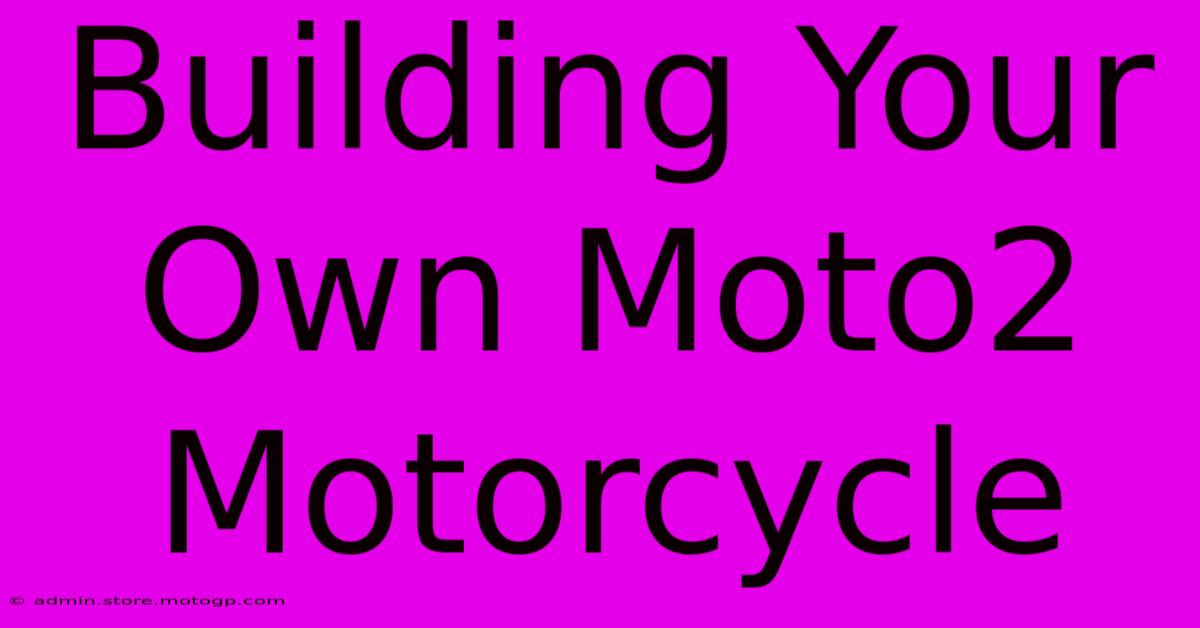Building Your Own Moto2 Motorcycle

Table of Contents
Building Your Own Moto2 Motorcycle: A Deep Dive into the Dream
Building your own Moto2 motorcycle is a monumental undertaking, a project that demands exceptional engineering skills, a significant financial investment, and an unwavering dedication to detail. This isn't a weekend project; it's a journey that could span years, requiring meticulous planning and unwavering persistence. This article will explore the complexities involved, highlighting the crucial steps and challenges you'll encounter along the way.
Understanding the Moto2 Regulations
Before even considering sourcing parts, you must thoroughly understand the Moto2 regulations. These rules, meticulously defined by the FIM (Fédération Internationale de Motocyclisme), dictate every aspect of the motorcycle's design, from the engine specifications to the permissible materials. Failure to comply will render your creation ineligible for competition, negating much of the effort involved.
Key Regulatory Aspects:
- Engine: The most significant constraint is the mandatory use of a Triumph 765cc three-cylinder engine. This engine is a highly specified unit, and modifications are strictly limited.
- Chassis: While the chassis design is largely open, there are strict rules concerning dimensions, materials, and safety features. Lightweight materials such as carbon fiber are common, but their integration requires advanced knowledge of composite construction.
- Electronics: The electronics package is also regulated, limiting the options available for data acquisition, engine management, and traction control. Understanding these limitations is crucial for efficient design and integration.
- Safety: Moto2 places a strong emphasis on rider safety. Regulations cover various safety aspects, including the fuel tank, brakes, and the overall structural integrity of the chassis.
Sourcing Components: A Complex Puzzle
Acquiring the necessary components is another significant hurdle. Many parts are specialized and sourced from specialized manufacturers, some of whom may not cater to individual builders. You'll need a deep understanding of the supply chain and strong relationships with suppliers.
Key Components and Sourcing Challenges:
- Triumph 765cc Engine: This is the heart of the motorcycle and the most straightforward component to acquire, albeit still expensive.
- Chassis: Designing and fabricating the chassis is arguably the most challenging aspect. This requires advanced CAD skills, specialized machining capabilities, and a deep understanding of structural mechanics. Consider partnering with an experienced chassis builder.
- Suspension: High-performance suspension components are crucial. You'll need to source top-quality forks, shocks, and linkages, potentially from specialized manufacturers or through the used market.
- Electronics: Sourcing the regulated electronics package can be complex. Many components are proprietary or custom-built, requiring careful research and potentially bespoke solutions.
- Bodywork: Aerodynamic bodywork is critical in Moto2. You'll need to invest in either high-quality carbon fiber fabrication or partner with a company specializing in this area.
The Build Process: Precision and Patience
Building a Moto2 motorcycle demands extreme precision and a meticulous approach. Every component must be correctly installed and integrated with the others. Any compromise in quality or precision could compromise the performance and safety of the machine.
Crucial Steps in the Build Process:
- Chassis Assembly: Carefully assemble the chassis, ensuring precise alignment and structural integrity.
- Engine Installation: Mount the Triumph engine securely and correctly, connecting all the necessary systems.
- Suspension Integration: Install and adjust the suspension components for optimal handling and performance.
- Electronics Installation and Calibration: Install and meticulously calibrate the electronics package.
- Bodywork Integration: Fit the aerodynamic bodywork, ensuring a perfect fit and minimizing drag.
- Testing and Tuning: Extensive testing and tuning are required to optimize performance and handling.
The Financial Commitment: A Significant Investment
Building a Moto2 motorcycle is an extremely expensive endeavor. The cost of parts, specialized tooling, and potential engineering support can easily reach hundreds of thousands of dollars. This excludes the time investment, which can easily reach thousands of hours. Careful budgeting and financial planning are essential.
Conclusion: A Triumph of Engineering and Perseverance
Building your own Moto2 motorcycle is an ambitious but incredibly rewarding endeavor. It demands exceptional skills, significant resources, and unwavering dedication. However, for those with the passion, expertise, and financial means, the result is a testament to their engineering prowess and a truly unique achievement. Remember that thorough planning, meticulous execution, and adherence to the stringent Moto2 regulations are paramount to success.

Thank you for visiting our website wich cover about Building Your Own Moto2 Motorcycle. We hope the information provided has been useful to you. Feel free to contact us if you have any questions or need further assistance. See you next time and dont miss to bookmark.
Featured Posts
-
Understanding The Nuances Of Moto Gp Tracks
Feb 18, 2025
-
Moto 2 Specs A Guide For Aspiring Racers
Feb 18, 2025
-
Moto Gp A Sport Like No Other Tnt Sports
Feb 18, 2025
-
Moto Gp Viewing Just Got Easier Tnt Sports Schedule
Feb 18, 2025
-
Austin Gp Concert An Unforgettable Spectacle
Feb 18, 2025
